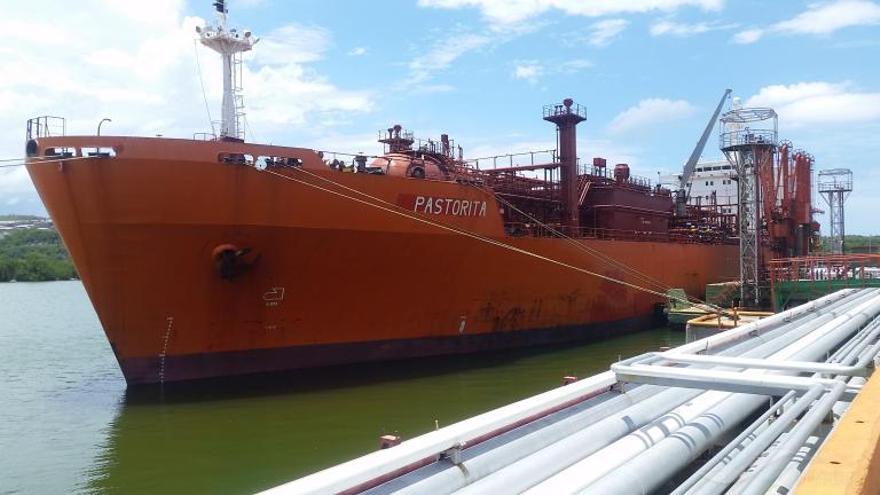
![]() 14ymedio, Havana, 5 September 2023 — Venezuela sent 65,000 barrels per day (bpd) of oil, fuel oil, gasoline and diesel to Cuba during the month of August, an amount higher than the previous month, when the Island received 53,000 bpd. The supply, stable compared to that of the rest of the year, coincides with a resounding drop in Venezuelan fuel exports of 38% compared to July, a figure that breaks with the growth trend that Caracas had maintained for three and a half years.
14ymedio, Havana, 5 September 2023 — Venezuela sent 65,000 barrels per day (bpd) of oil, fuel oil, gasoline and diesel to Cuba during the month of August, an amount higher than the previous month, when the Island received 53,000 bpd. The supply, stable compared to that of the rest of the year, coincides with a resounding drop in Venezuelan fuel exports of 38% compared to July, a figure that breaks with the growth trend that Caracas had maintained for three and a half years.
Of the 554,000 bpd that the country sold to its partners in August – 333,000 less than in July, when it exported 877,000 bpd – most of it went to China, although the exact amount is not known, the British agency Reuters reported. For its part, the United States bought through the Chevron company, the only one authorized by the Treasury Department since 2022 to do business with Venezuela, less than 147,000 bpd.
The terrible state of the country’s oil infrastructure and the lack of capital of the state-owned PDVSA have limited, according to Reuters, the possibilities of exporting Venezuelan crude oil. In addition, breakdowns have been recorded in important fuel improvement units, several of them financed by Caracas partners such as Beijing or Moscow.
The official press discreetly announced this Friday that the Alameda-2 oil well, located in Matanzas, was in a position to be exploited
The movement of tankers from Venezuela through Cuban ports has not stopped in recent months. In addition, the official press discreetly announced this Friday that the Alameda-2 oil well, located in Matanzas, was in a position to be exploited by the Australian company Melbana Energy.
Osvaldo López, head of Exploration of the Cuba-Oil Union (CUPET), then told Cubadebate – which claimed to have the intention of resolving the “doubts and expectations” of Cubans on the subject – that Melbana had the right over the well in a “shared” way, thanks to a contract signed with the Cuban Government in 2015.
Since that year, Melbana has examined 19 possible wells, without publishing clear results so far. In 2020, in addition, the Angolan company Sonangol, which pays for 70% of Melbana’s oil activities on the Island, was added to the equation, López reported. The following year, one of the analyzed wells was dredged, but it was useless for any activity that was not “exploration,” the company alleged.
After investigating other sites, which ended up being “dry,” Melbana said that it has managed to get about 1,100 bpd from Alameda-2 during the month of July. Crude has also been taken out, “lighter and with lower sulfur content” than usual on the Island, it added. However, the extraction is still just an “experimental exploitation” project, and López does not hide CUPET’s lack of enthusiasm for the “new discovery,” which he values just as “positive.”
Since 2015, Melbana has examined 19 possible wells, without publishing clear results so far
On the other hand, Havana continues to pay more interest to ships that, from Caracas and Mexico, bring fuel to the Island. This Tuesday, the Cuban tanker Pastorita appeared anchored in the port of Havana without it being possible to determine, using maritime tracking applications, from which foreign terminal it had sailed.
The oil tanker Alicia – with a Cuban flag – arrived in Matanzas on August 25 from the Venezuelan port of Amuay, while the Aquila, with a Panamanian flag, arrived this Sunday at the same terminal from Mariel.
The Finnstraum, with a Norwegian flag, is expected to arrive in Moa on September 15 from Finland, where another freighter is already anchored, the Praire Tulip, which sails with the Portuguese flag from Curaçao.
Translated by Regina Anavy
________________________________
COLLABORATE WITH OUR WORK: The 14ymedio team is committed to practicing serious journalism that reflects Cuba’s reality in all its depth. Thank you for joining us on this long journey. We invite you to continue supporting us by becoming a member of 14ymedio now. Together we can continue transforming journalism in Cuba.
